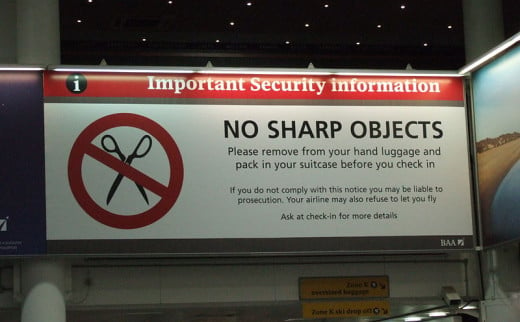Air Travel Packing Regulations
Traveling in a Post-9/11 World
One of the biggest irritants in travel since the advent of enhanced security measures can be standing in the TSA security line at an airport and then having to unload everything in a carry-on bag for investigation. The biggest pain in travel is having to throw away a health or hygiene product that is still perfectly good because it did not meet the requirements that have been sent down the line over the past decade.
Preparation is the key to making an intense search less likely. There are random searches, but there is no need to give a cause that invites a search. The following article will detail some of the most recent requirements that can help travelers avoid a major hassle at the airport.

Packing a Carry-on Bag
Every passenger who boards a plane is entitled to bring a carry-on bag into the cabin. The carry-on must fit either in the overhead bins that line the ceiling of the cabin or under the seat in front of the passenger who brings it onto the plane.
Checked luggage can get lost, regardless of the airline used. Many travelers choose to pack a change or two of clothes and personal hygiene items in their carry-on. This is a great idea that can avoid some serious problems. I personally spent 12 days in Africa with 2 changes of clothing that I had only because I packed them in my carry-on. Had I not prepared and packed something less important, I would have been in a great deal of trouble and would have had to buy everything I needed after landing. In some parts of the world, this is easier said than done.
After a massive bomb scare in which a terrorist attempted to ignite chemicals to bring down a plane en route, the TSA instituted additional restrictions on what travelers can bring into an airplane's cabin. The complete up-to-date list of prohibited items is available on the TSA's website. The main thing that travelers should remember about packing liquids, gels, and aerosols in their carry-on is the 3-1-1 rule. Any restricted liquids, gels, and aerosols are limited to a 3.4-ounce container. This is the 3 in the 3-1-1. The two 1s refer to 1 quart-size clear zip-lock style bag and 1 bag per passenger. These bags have to be placed in one of the plastic bins that get a quick x-ray in the security line.
This bag is the place to put deodorant, toothpaste, mouthwash, cologne or perfume, and any other item that qualifies. The screeners are quite adamant about the 3.4-ounce limit. I've personally had to throw away a nearly-full tube of toothpaste in the line. There are exceptions to this limit, but they are basically limited to items needed by infants, such as baby formula, breast milk, and baby food. These items should be removed and declared before starting the security process to avoid extensive delays. Making sure to pack correctly can save time and hassle when getting through security, and everyone will have a better experience with a shorter wait time.
Packing Checked Baggage
Many of the items that air travelers back in their checked bags cause no problems and have no restrictions. Clothes and shoes would fall into this category. There are many items that are restricted from the cabin and that need to go into the checked baggage. With the cost of checked baggage on most airlines, it is actually best to avoid bringing unnecessary items that have to be checked in.
Those who are hunting or golfing may have trouble getting by with only a checked bag since their tools include guns or golf clubs. Firearms and sporting equipment have to be placed under the cabin. Unloaded firearms can only be transported in hard-sided, locked containers. Gunpowder and flares are prohibited, even under the plane. Sharp objects that include weapons or other items that could be used as weapons must go under the plane. These should be wrapped so as to protect the safety of those who pack and unpack the plane. Sporting equipment must also go under the plane. Those who have a specific question regarding a specific item should direct their inquiry to the TSA's website, which lists just about every item that people would want to take on a plane.
Traveling with Babies and Small Children
Traveling with small children is always a challenge. As mentioned above, the airlines and the security apparatus are attuned to the special needs of babies and small children. Exceptions to the normal restrictions related to liquids and gels are waived for those traveling with babies. Baby formula, baby food, and breast milk are among those liquids that are allowed in containers larger than 3.4 ounces.
Transporting babies in automobiles requires the use of a car seat. Baby carriers are permitted for those babies who have their own seats. Those who choose to hold their children who are under two years of age will have to gate check their baby carriers under the plane (this is not the same as checking luggage which checking in for the flight). Strollers are permitted past the security check, but, like baby carriers or car seats, they must be gate checked.
Basically no one likes the process of airport security. There are, however, steps that can be taken by travelers before arriving at the airport that can make the unpopular process a bit more bearable. Hopefully, this information provided some useful tips that can help flyers avoid useless delays and scrutiny.








